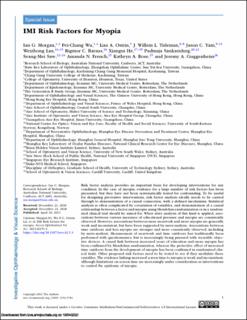| dc.contributor.author | Morgan, Ian G. | |
| dc.contributor.author | Wu, Pei-Chang | |
| dc.contributor.author | Ostrin, Lisa A. | |
| dc.contributor.author | Tideman, Willem | |
| dc.contributor.author | Yam, Jason C. | |
| dc.contributor.author | Lan, Wiezhong | |
| dc.contributor.author | Baraas, Rigmor C. | |
| dc.contributor.author | He, Xiangui | |
| dc.contributor.author | Padmaja, Sankaridurg | |
| dc.contributor.author | Seang-Mei, Saw | |
| dc.contributor.author | French, Amanda | |
| dc.contributor.author | Rose, Kathryn A. | |
| dc.contributor.author | Guggenheim, Jeremy A. | |
| dc.date.accessioned | 2022-02-14T13:10:45Z | |
| dc.date.available | 2022-02-14T13:10:45Z | |
| dc.date.created | 2022-02-04T10:47:49Z | |
| dc.date.issued | 2021 | |
| dc.identifier.citation | Morgan, I. G., Wu, P.-C., Ostrin, L. A., Tideman, J. W. L., Yam, J. C., Lan, W., Baraas, R. C., He, X., Sankaridurg, P., Saw, S.-M., French, A. N., Rose, K. A. & Guggenheim, J. A. (2021). IMI Risk Factors for Myopia. Investigative Ophthalmology & Visual Science, 62(5), Artikkel 3. | en_US |
| dc.identifier.issn | 0146-0404 | |
| dc.identifier.uri | https://hdl.handle.net/11250/2978834 | |
| dc.description.abstract | Risk factor analysis provides an important basis for developing interventions for any condition. In the case of myopia, evidence for a large number of risk factors has been presented, but they have not been systematically tested for confounding. To be useful for designing preventive interventions, risk factor analysis ideally needs to be carried through to demonstration of a causal connection, with a defined mechanism. Statistical analysis is often complicated by covariation of variables, and demonstration of a causal relationship between a factor and myopia using Mendelian randomization or in a randomized clinical trial should be aimed for. When strict analysis of this kind is applied, associations between various measures of educational pressure and myopia are consistently observed. However, associations between more nearwork and more myopia are generally weak and inconsistent, but have been supported by meta-analysis. Associations between time outdoors and less myopia are stronger and more consistently observed, including by meta-analysis. Measurement of nearwork and time outdoors has traditionally been performed with questionnaires, but is increasingly being pursued with wearable objective devices. A causal link between increased years of education and more myopia has been confirmed by Mendelian randomization, whereas the protective effect of increased time outdoors from the development of myopia has been confirmed in randomized clinical trials. Other proposed risk factors need to be tested to see if they modulate these variables. The evidence linking increased screen time to myopia is weak and inconsistent, although limitations on screen time are increasingly under consideration as interventions to control the epidemic of myopia. | en_US |
| dc.language.iso | eng | en_US |
| dc.rights | Attribution-NonCommercial-NoDerivatives 4.0 Internasjonal | * |
| dc.rights.uri | http://creativecommons.org/licenses/by-nc-nd/4.0/deed.no | * |
| dc.title | IMI Risk Factors for Myopia | en_US |
| dc.type | Peer reviewed | en_US |
| dc.type | Journal article | en_US |
| dc.description.version | publishedVersion | en_US |
| dc.rights.holder | © 2021 The Authors. | en_US |
| dc.source.volume | 62 | en_US |
| dc.source.journal | Investigative Ophthalmology and Visual Science | en_US |
| dc.source.issue | 5 | en_US |
| dc.identifier.doi | https://doi.org/10.1167/iovs.62.5.3 | |
| dc.identifier.cristin | 1997706 | |
| dc.source.articlenumber | 3 | en_US |
| cristin.ispublished | true | |
| cristin.fulltext | original | |
| cristin.qualitycode | 2 | |

